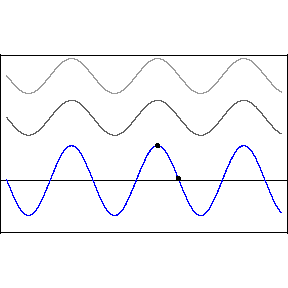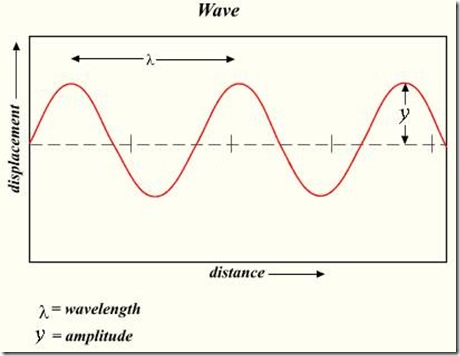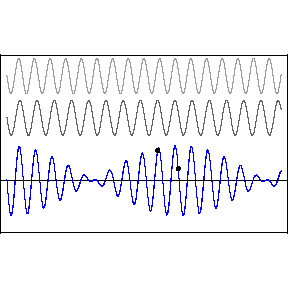A wave is a disturbance that propagates through space and time, usually with transferrance of energy. Waves travel and transfer energy from one point to another, often with little or no permanent displacement of the particles of the medium (that is, with little or no associated mass transport); instead there are oscillations around almost fixed positions. Wave energy may be a vibration as in sound waves. Electromagnetic waves start from a source point and oscillate at specific measurable frequencies. These frequencies are similar to a “fingerprint” in that they uniquely identify the source. Each chemical, element, virus, bacteria have a unique and distinguishable frequency (or wave). These frequencies can be measured. Waves can interfere with other waves. A wave can be measured and represented as follows:
Abnormal Biological Conductance Wave: a non-coherent wave, arising from any subset of structural organization (sub-atomic, atomic, molecular etc.) that produces destructive interference. The non-coherent wave will result in a decrease in amplitude (voltage), a decrease in force of the conductance wave and an increase of skin resistance. A single non-coherent wave arising from any subset may result in conductance that cannot be maintained when a positive probe of 1.25 volts and 10-12 micro-amps is applied at the skin detection site. Conductance is restored when a signal of the non-coherent wave is introduced into the circuitry either as a substance (analog wave) or as a digitized code of the substance.
Biological Conductance: a general term describing electromagnetic resonance and energy associated with information transfer in biological subjects.
Code: a modulated wave of constant height and variable width, capable of being stored in a computer program.
Coherent wave: a superpositioned wave that does not interfere with other waves in the conductance pathway.
Conductance Pathway: a discrete electromagnetic, non-anatomic path of conducted, resonating frequencies that arise at the site of origin within the body and terminate at the skin detection site. Conductance pathways are associated with other conductance pathways at secondary and tertiary branch points and are capable of interacting with these conductance pathways. As a result signals may be detectable in more than one detection array.
Conductance: the reciprocal of resistance, measured in mhos or siemens90.
Current: The flow of electrons in an electrical circuit measured in amperes90.
Electrodermal Profile: An outline of non-coherent electromagnetic codes and the electromagnetic sites at which they are found as a basis for restoring biological conductance.
Electrodermal Detection: a method of determining biological conductance by measurement of skin resistance.
Glossary: A list in plain language explaining the source of electromagnetic codes used in electrodermal detection.
Interference: the superposition of similar waves moving through a medium. The resulting wave is found by adding the individual waves together point by point.
When waves meet crest-to-crest and trough-to-trough, they undergo constructive interference: the frequency is the same but the amplitude has increased.
When crests meets trough, the wave undergoes destructive interference. The frequency is the same but the amplitude has decreased76.
Main Detection Site: A special detection site in the detection array that can represent detection sites located in the entire array. They are generally located in a peripheral site on the fingers and toes. In electropuncture terminology they called Control Measurement Points (CMP) or Kontrollmeßpunkt (KMP) in German.
Matrix: The complex organic and inorganic sol-gel electrolyte solution through which biological electromagnetic signals are transmitted.
Medical Profile: an outline of findings from studying a case: history, physical examination, laboratory and other inquiries by those trained in that paradigm in order to make a diagnosis and treat.
Non-coherent wave: an oscillating frequency that produces a phase shift in a superpositioned wave resulting in destructive interference. The following provides us a picture of this phenomenon:

The following represents two sine waves with different frequencies: Beats-
Normal biological conductance wave: a complex waveform arising from a site of origin in the body having variable frequencies and variable amplitudes but having its own identifying characteristic. If all of the components of the biological wave are harmonious they produce a conductance bio-resonance that is able to maintain constant amplitude and current.
Normal conductance: the radiant effect of complex waves with multiple frequencies generated from a variety of sources ranging from subatomic particles, to atoms, to molecules, to complex molecules, to tissues and organs.
Phase shift: Change in the superposition of a normal wave by a non- coherent wave causing destructive interference and a disharmonic bio-resonance at the site of origin
Ohm’s Law: a basic law of electronics that expresses a relationship between current, voltage and resistance. Current (I) =Volts (E)/Resistance
(R.).
Process of Iteration: A process of eliminating non-coherent waves in an electrodermal profile by a repetition of the same process until the non-coherent wave is no longer detectable.
Pulse-width Equivalent Wave (PWE): The square wave equivalent code of the biological wave resulting from analog to digital conversion.
Resistance: opposition to current flow, measured in ohms.
Sarcodes: Homeopathic preparations made from animal organs by various manufactures; WALA, Dolisos, Heel and Staufen. They were used extensively in correlating electromagnetic sites of detection with electromagnetic sites of origin . Example: An indicator drop at TW20 indicates non-conductance due to a non-coherent wave at that skin detection site. If, after screening through a group of organ preparations, it was found that conductance could be restored by placing a pituitary organ preparation in the circuitry, than the skin site was designated as the electromagnetic site of the electromagnetic code for the pituitary gland. Detection of non-coherent waves at that site are considered to be associated with the pituitary electromagnetic site of origin.
Secondary Array: an array of detection sites branching from the primary detection array at the secondary detection branch point.
Secondary Detection Site: A detection site on the primary array from which a secondary array may be detected. It is referred to as a branch point in electro-acupuncture terminology.
Signal: An electromagnetic resonance having a characteristic amplitude and frequency.
Sites of Origin: the electromagnetic sites where resonating frequencies originate. These sites correspond to the anatomical site associated with a sarcode made from an organ preparation from that anatomical site.
Skin Detection Array: skin detection sites are arranged in a linear fashion on the surface of the skin. In general they correspond to acupuncture points and meridians in their location and distribution. As in the conductance pathway there is also conductance along the detection array. Detection sites along the detection array may be amplified by pressure or electrical stimuli and then transferred to the main detection site for evaluation.
Skin Detection Site: termination on the skin of a resonating electromagnetic frequency generated at a site of origin.
Superposition: one or more waves traveling through the same medium at the same time
Tertiary Array: an array of detection sites branching from the secondary detection array.
Tertiary Detection Site: A detection site branching from a secondary detection array.
Voltage: the electromotive force (EMF) or pressure that causes electrons to move in an electrical circuit, measured in volts.
Bibliography
Bechtloff, Friedrich, Electroakupunctur nach Voll: EAV; eine Darstellung in Bereichen (Uelzen: Medizinisch Literarische Verlagsgesellshaft 1991)
Gerber, Richard, Vibrational Medicine (Santa Fe: Bear & Company 1988)
Hecker,Hans-Ulrich, Steveling, Angelica, Peuker, Elmar, Kastner Jörg & Liebchen, Kay, Color Atlas of Acupuncture (Stuttgart: Thieme 1999)
Kenyon, Julian N., Modern Techniques of Acupuncture Volume I-III (Willingborough, Northamptonshire England: Thorsons Publishing Group 1985)
Leber, Douglas C. Acupro II System™, Computronix Corporation, 1991
Ortega, Proceso S., Notes on the Miasms (New Dehli: National Homeopathic Pharmacy 1980)
Petzold, Charles, Code (Redmond: Microsoft Press 1999)
Voll, Reinhold, The 860 Measurement Points of the Meridians and Vessels Including The Secondary Vessels (Uelzen: Medizinisch Literarische Verlagsgesellshaft mbH 1983)
Voll, Reinhold, Topical Positions of the Measurement Points in Electro-Acupuncture, Volume I-IV (Uelzen:Medizinisch Literarische Verlagsgesellshaft mbH 1977)
Werner, Fritz, Electro-acupuncture Primer (Uelzen: Medizinisch Litarische Verlagsgesellschaft mbH 1979)

